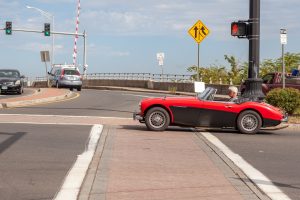January 29, 2020
 Accommodating all moving vehicles and pedestrians on a town or city’s streets so they can all transit safely can be difficult, but it’s necessary as more and more people use alternative methods of transportation such as biking or public transportation. Norwalk’s 10-year Citywide Plan (Plan of Conservation and Development) envisions adopting Complete Streets and Vision Zero Initiatives to make its streets safer. Vision Zero is a different way of approaching traffic planning and policies with the goal of improving road safety so there are no deaths or serious injuries. Complete Streets is an approach to city street design and policies that promotes safe, convenient, and equitable mobility and forms of transportation for everyone, especially children, people with disabilities, and older adults. Below we take a closer look at these two initiatives.
Accommodating all moving vehicles and pedestrians on a town or city’s streets so they can all transit safely can be difficult, but it’s necessary as more and more people use alternative methods of transportation such as biking or public transportation. Norwalk’s 10-year Citywide Plan (Plan of Conservation and Development) envisions adopting Complete Streets and Vision Zero Initiatives to make its streets safer. Vision Zero is a different way of approaching traffic planning and policies with the goal of improving road safety so there are no deaths or serious injuries. Complete Streets is an approach to city street design and policies that promotes safe, convenient, and equitable mobility and forms of transportation for everyone, especially children, people with disabilities, and older adults. Below we take a closer look at these two initiatives.
What is Vision Zero?
The Vision Zero movement considers traffic safety as a public health issue, believing that traffic accidents, deaths, and injuries can be prevented through design, engineering, policies, enforcement, community engagement, and education. Vision Zero plans bring together a wide variety of stakeholders, with collaboration among local traffic planners and engineers, policymakers, and public health professionals to work on the many factors that go into making roadways safe including roadway design, speeds, behaviors, technology, and policies. The movement, which began in Sweden in 1997, has grown across Europe and in the United States. Cities that have implemented Vision Zero in the U.S. include New York City, Boston, Charlotte, North Carolina, Denver Colorado, Tempe Arizona, and Bellevue, Washington, among others.
What is Complete Streets?
Complete Streets complements Vision Zero with the goal of having streets that are safe for everyone, from motorists to public transportation riders, bicyclists to pedestrians. Some ways to do this is to integrate better roadway design with safe access in mind for all different types of mobility through the city when improving existing streets and designing new ones. What this looks like depends on the city or town, but could include adding sidewalks, bike lanes, special bus lanes, safe public transportation stops, clearly marked and accessible crosswalks, median islands and pedestrian-designated signals.
Vision Zero & Complete Streets for Norwalk
The new Norwalk 10-year Citywide Plan contains details about adopting both Vision Zero and Complete Streets initiatives. Vision Zero will be used as an added safety layer on top of Complete Streets to establish equitable mobility for all kinds of people throughout all city operated roadways. The initiatives will include community engagement to identify concerns and discuss options before changes are made. Key city departments involved will include, the Mayor’s office, Common Council, Transportation, Mobility, and Parking, Planning and Zoning, Public Health, the Bike-Walk Commission, as well as the Fire and Police Departments.
Some of the plans to reach the Vision Zero and Complete Streets goals include developing long-range transportation plans with an eye to safety that include many modes of transportation (motor vehicles, buses, bicyclists, pedestrians, and mobility devices , such as senior scooters), and giving other transportation options, such as biking and walking, a high priority. Specific steps may include creating safe pedestrian access to bus and transit stops as well as to new commercial and mixed-use development areas, allocating space for pick-up/drop-off and vehicular and bicycle parking in busy urban areas, and investing in new sidewalks as well as bicycle and walking facilities throughout the city.




